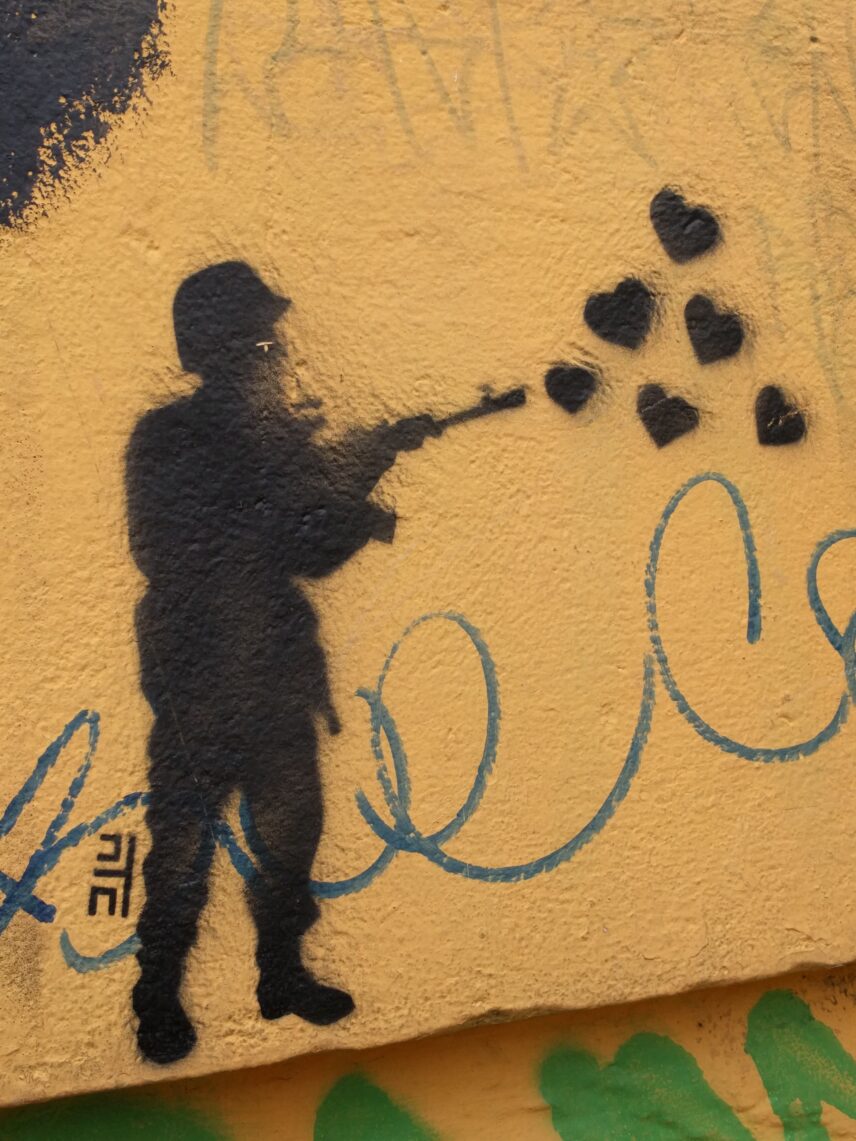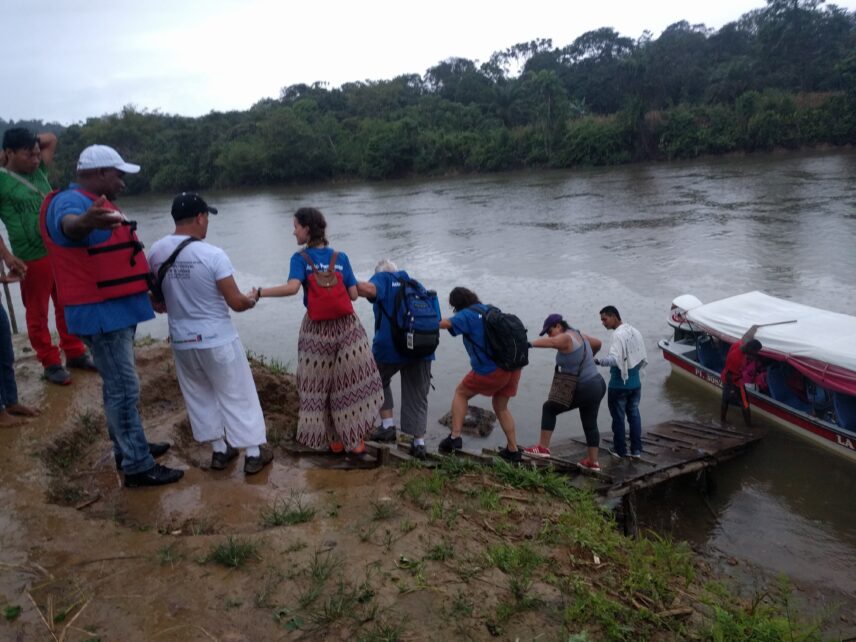Article begins
We sat on squeaky plastic chairs, outside on the red dirt in the community of La Toma, Colombia. Thirteen US residents—Black, white, and brown—mixed among about 30 community members sipping tinto, a traditional sweet Colombian coffee, and listening to testimonies of those who had been threatened or lost loved ones due to illegal armed groups or mining projects. They were struggling to maintain and build community connections amid continued violence and extractivist projects. It was 2013, and I was on my first trip to Colombia. The trip was organized through the nonprofit organization Witness for Peace, which strives to create connections of solidarity between US residents and activists across the Americas confronting US imperialism and empire. While we sat and drank our tinto, a woman told us about her husband who had been murdered, and a man spoke of efforts to create clubs for youth to help them evade the pressures of joining leftist guerillas or right-wing paramilitaries. We felt the pulse, the affective reality of what US funds support, teach, and hope for: communal destruction for economic profit. Soon, however, the testimonial microphone gave way to a vibrant sound system playing music from a local band.
We peeled ourselves out of the plastic chairs and community members made a triumphant effort to teach us awkward, shy gringos how to dance. We sashayed and stumbled into a long semicircle of a conga line and danced until the community used its available electricity for the day. The music was replaced by intermittent attempts at interpreted or haphazardly Spanglish conversations.
As we piled back onto our bus to return to our hostel, there was a hum of muted excitement. We got a brief glimpse not just of US imperialism but of what activists and community members were striving to preserve and build: joy, community, hope. In return, they asked for our “solidarity.” But how would we deliver? What is solidarity, anyway?
La Toma is an Afro-Colombian community that has long sat at the intersection of extractive industries—especially gold mining—and violence from right-wing paramilitaries, guerillas, and government forces. At the time of our visit, we were welcomed into the community by then-budding lawyer and community activist Francia Márquez, who is now the vice president of Colombia. Over the past 10 years, a lot has changed, but much has also remained the same.

The United States’ role in Colombia is not unique throughout the region. There is a long history of US imperial politics in Latin America and the Caribbean. Resistance efforts across the region have engendered support from residents within the United States, from the 1960s Venceremos brigades to Cuba, pre- and post-coup solidarity with Salvador Allende and his supporters in Chile, the 1980s Central American Solidarity and sanctuary movement, and efforts combating Plan Colombia in the 2000s. US activists have referred to such transnational collaboration as “solidarity.” However, the meaning of “solidarity” has shifted over time in congruence with changing socioeconomic and political conditions across the Americas.
What does solidarity mean when one lives thousands of miles away in the heart of an empire and may not even speak the language? After my first trip to Colombia in 2013, I began to grapple with this question. We had all returned to various cities across the United States with concrete requests to “be in solidarity.” We wrote a report, posted a YouTube video, wrote op-eds, and more. But did this count as solidarity? Driven by my own internal need to understand, I dedicated the next 10 years and counting to grappling with this question. To try to understand solidarity, I shifted to look at how others who claim to be in solidarity define it, and thus in many ways how solidarity defines itself. How do US residents understand solidarity, and how does that impact how they enact it?
For US activists, understandings of solidarity have been influenced by the political and socioeconomic context of their country as well as the specific struggles activists are working toward in various Latin American nations. In the 1960s, solidarity in the United States was animated with the fervor of anticolonial, Black liberation, and anticapitalist movements gaining traction across the globe. For activists in the United States who were conterminously involved in the civil rights, antiwar, and decolonial movements, solidarity was about learning practices of joint liberation, countering Cold War dominance, and exploring alternative political and economic projects. This was best exemplified through solidarity projects with Cuba, particularly the Venceremos brigades in which Black radicals, laborers, and everyday activists went to Cuba to learn from their revolutionary struggle, bring liberatory practices back to the United States, and work in service to the revolution.
As political projects threatening the hegemony of US empire and imperialism established transnational collaboration, so too did intergovernmental projects of repression, such as Plan Condor. Throughout the Cold War, campaigns of discreditation against capitalist alternatives flourished in the United States, and identity-based and human-rights-focused campaigns became more prominent. Framings of solidarity also shifted from joint ventures at co-constructing capitalist alternatives across the globe to “calling out” political harms through human rights language. This shift in tactics was seen in the 1980s Central American Solidarity movement that united against US support for right-wing governments and armed groups in El Salvador, Nicaragua, and Guatemala. Many older activists today involved in US Latin America solidarity were trained in techniques and tactics during this movement.
Kathleen, a white activist who deepened her involvement in solidarity in the 1980s by traveling to Nicaragua, noted that she understood solidarity dualistically. To her, solidarity was both an intellectual project, understanding and being a part of a revolution, and an affective interpersonal relationship between those who became her friends and comrades. She noted that solidarity in support of a revolution is “quite abstract”:
It’s not solidarity with a particular person, it’s like movement. . . . I think that solidarity very quickly became far more personal [for me] because I was living with and walking among people. It became really important to me to try to understand what it meant to share their lives . . . I worked to provide some margin of safety, however invisible it might have been, by communicating constantly back to the United States what I was learning and what I believed the reality was on the ground so that people in the United States could live out that other dimension of solidarity which is acting to change the situation.
Kathleen underscores the notion of truth and witness, of countering hegemonic narratives that legitimate and/or justify US-supported violence. Despite Kathleen’s reference to a revolution, not all variants of US solidarity have foregrounded support for an alternative political project or revolution. Instead, as human rights discourse rose, some activists in the US created a narrative that depicted deserving victims versus a heroic savior—a North–South inflection. US activists still recognized their interconnections across the Americas, shared a mutual political goal, and were engaged in more than individual acts of charity. However, though the participants in the movement had varied political goals and ideals, the externally framed scope of their political goals had begun to shift from full-scale revolution to more atomized human rights reforms. Ideas of revolution, even when present, were overshadowed by victimhood, the US’s moral responsibility to end harm, and the individual US activists’ role to create change. Slowly, solidarity became framed through moral calls of injustice rather than political calls for alternative anticapitalist or imperial projects. In many ways, solidarity also became most accessible for those with race, class, and nationality privileges—a technocratic project open to those with more time and resources. This shift reflects how neoliberalism has atomized both activists and the tactics of solidarity.

Kathleen also comments on the role of those in the United States who can “act to change the situation.” Today, such actions are most frequently framed through human rights petitions, letters to government officials, small protests, educational meetings, and accompaniment. For example, in 2017 in Buenaventura, Colombia, activists and everyday residents held a three-week civic strike to call attention to and demand public investment in civilian lives. Following years of cross-coalitional planning, residents shut down the port and the city and took to the streets to demand recognition. The abandonment of Buenaventura’s primarily Afro-Colombian residents in lieu of big businesses and the port has intensified since the 2012 implementation of a free-trade agreement between Colombia and the United States. Three of my interlocutors protested and accompanied Colombian activists, sharing tear-gassed air and triumphant calls of community. When they collected the tear gas canisters, they found they were made in and sent from the US company CTS, Combined Tactical Systems Inc. Though not directly provided by the US government, my interlocuters suspected that the weapons may have been bought with military aid money from the United States. This protest, eventually somewhat successful, preceded even larger (and widely repressed) nationwide protests in 2021 against neoliberal austerity. But after these protests ended, among US solidarity activists, the immediate push to advocate against state repression of protesters decreased, conversations and planning dwindled, and there was less interaction centered on organizing a campaign in the United States to counter neoliberalism. On the heels of pressing and publicized protests, activists returned to their atomized work.
Despite these individualized tactics, when I spoke with my interlocutors, everyone expressed a desire to build some kind of alternative political project to counter existing modes of white supremacy, colonialism, and environmental degradation. Under a veneer of individualized activism and moralistic calls for change lies an inherently political understanding of solidarity, one that many admit is still changing and is not contained in a single action. As one interlocutor put it, “solidarity is common ground. [It] is feeling powerful together . . . an awareness of possibility that could overtake passivity.” Solidarity for my interlocutors was understood as an ongoing political relationship of interconnections, even if the contours and power dynamics of the specific North–South relationships varied over time. Interestingly, since the beginning of the genocide in Gaza, many of those involved in US-Latin American solidarity have been organizing and supporting calls for an immediate ceasefire. Their verbalizations of solidarity with Palestine highlight the connections between US financial and militarized support of policies that cause human rights abuses in Latin America and the global South. This cross-coalitional organizing demonstrates the exciting potential of a much broader connected and organized movement against imperialism.
Personally, the contours of solidarity have shifted from the days of my grant-funded trips to Colombia for accompaniment, research, or delegations to behind-the-scenes organizing that often takes place at a computer. With the onset of COVID-19 and financial limitations—not to mention a very attached toddler—my previous privileges of time and mobility have dramatically decreased. Recently, my solidarity efforts have included supporting a traveling art exhibit on Colombian activists, trying to help secure asylum for an immigrant, and working to organize a music and cultural tour in spring 2024 for Afro-Colombian activist Daira Quiñones. These efforts have been built without the warmth of tinto, the stick of hot plastic chairs, or the pulse of broader human presence. I, too, have fallen into the atomized, less energizing, and perhaps less impactful work of “solidarity.” But like my interlocutors, I too dream of something bigger, something modeled time and again by our compatriots in the South, a movement and unified pulse against US imperialism.
What does that mean for solidarity if the theory and the actions don’t quite match? Solidarity is highly contingent and contextual. It is hard. It changes, it morphs, it eludes us. And we mess up. And then we try again. What is solidarity? Perhaps above all, it is to be lived.
Joseph Feldman is the Society for Latin American and Caribbean Anthropology section editor.

